| Sichuan cuisine | |||||||
|---|---|---|---|---|---|---|---|
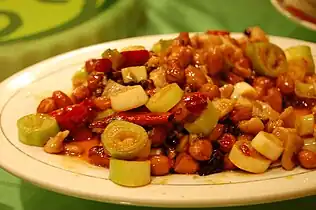 | |||||||
| Chinese | 四川菜 | ||||||
| |||||||
| Chuan cuisine | |||||||
| Chinese | 川菜 | ||||||
| |||||||
| Part of a series on |
| Chinese cuisine |
|---|
 |

Sichuan cuisine or Sichuanese cuisine, alternatively romanized as Szechwan cuisine or Szechuan cuisine (Chinese: ⓘ, Standard Mandarin pronunciation: [sɨ̂.ʈʂʰwán] ⓘ), is a style of Chinese cuisine originating from Sichuan province and the neighboring Chongqing municipality. Chongqing was formerly a part of Sichuan until 1997, thus there is a great deal of cultural overlap between the two administrative divisions. There are many regional, local variations of Sichuanese cuisine within Sichuan and Chongqing.
It has bold flavours, particularly the pungency and spiciness resulting from liberal use of garlic and chili peppers, as well as the unique flavour of Sichuan pepper. Some examples are Kung Pao chicken and Yuxiang shredded pork. Four sub-styles of Sichuan cuisine include Chongqing, Chengdu, Zigong and Buddhist vegetarian style.[1]
UNESCO declared Chengdu, the capital of Sichuan Province, to be a city of gastronomy in 2011 to recognise the sophistication of its cooking.[2]
History
Sichuan in the Middle Ages welcomed Middle Eastern crops, such as broad beans, sesame and walnuts. Since the 16th century, the list of major crops in Sichuan has even been lengthened by New World newcomers. The characteristic chili pepper came from Mexico, but probably overland from India or by river from Macau, complementing the traditional Sichuan peppercorn (花椒; huājiāo). Other newcomers from the New World included maize (corn), which largely replaced millet; white potatoes introduced by Catholic missions; and sweet potatoes. The population of Sichuan was cut by perhaps three quarters in the wars from the Ming dynasty to the Qing dynasty. Settlers from the adjacent Hunan Province brought their cooking styles with them.[3]
Sichuan is colloquially known as the "heavenly country" due to its abundance of food and natural resources. One ancient Chinese account declared that the "people of Sichuan uphold good flavour, and they are fond of hot and spicy taste." Most Sichuan dishes are spicy, although a typical meal includes non-spicy dishes to cool the palate. Sichuan cuisine is composed of seven basic flavours: sweet, sour, numbing-spicy (like in Sichuan pepper), spicy, bitter, fragrant/aromatic, and salty. Sichuan food is divided into five different types: sumptuous banquet, ordinary banquet, popularised food, household-style food and snacks. Milder versions of Sichuan dishes remain a staple of American Chinese cuisine.[4]
The superior natural resources of Sichuan Province provided plenty natural resources for the development of cooking. The flow of the Yangtze river through Sichuan Province provided nutrients for fundamental foods, spices, and a source of water.[5]
Features
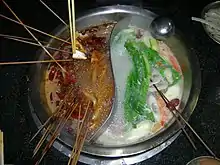
The complex topography of Sichuan Province, including its mountains, hills, plains, plateaus and the Sichuan Basin, has shaped its food customs with versatile and distinct ingredients.
Abundant rice and vegetables are produced from the fertile Sichuan Basin, whereas a wide variety of herbs, mushrooms and other fungi prosper in the highland regions. Pork is overwhelmingly the most common type of meat consumed.[3] Beef is somewhat more common in Sichuan cuisine than it is in other Chinese cuisines, perhaps due to the prevalence of oxen in the region.[6] Sichuan cuisine also uses various bovine and porcine organs as ingredients, such as intestine, arteries, head, tongue, skin and liver, in addition to other commonly used portions of the meat. Rabbit meat is also much more popular in Sichuan than elsewhere in China. It is estimated that the Sichuan Basin and Chongqing area are responsible for about 70 percent of China's total rabbit meat consumption.[7] Yoghurt, which probably spread from India through Tibet in medieval times, is consumed among the Han Chinese. This is an unusual custom in other parts of the country. The salt produced from Sichuan salt springs and wells, unlike sea salt, does not contain iodine, which led to goiter problems before the 20th century.[3]
Sichuan cuisine often contains food preserved through pickling, salting and drying. Preserved dishes are generally served as spicy dishes with heavy application of chili oil.
The most unique and important spice in Sichuan cuisine is the Sichuan pepper (花椒; huājiāo; 'flower pepper'). Sichuan peppercorn has an intense fragrant, citrus-like flavour and produces a "tingly-numbing" (麻; má) sensation in the mouth. Other commonly used spices in Sichuan cuisine are garlic, chili peppers, ginger and star anise.
Broad bean chili paste (豆瓣酱; 豆瓣醬; dòubànjiàng) is one of the most important seasonings.[3] It is an essential component to famous dishes such as Mapo tofu and double-cooked pork slices. Sichuan cuisine is the origin of several prominent sauces/flavours widely used in modern Chinese cuisine, including:
Other examples of mixed flavor including spicy and hot (Mala), fish flavor (Yuxiang), hot and sour, the five spices (Wuxiang; 五香), ginger juice, mashed garlic, sweet and sour, spice salt (Jiaoyan; 椒盐), dried tangerine or orange peel (Chenpi; 陈皮), burnt chili, pot-stewed fowl (Lu; 卤味), odd flavor (Guaiwei; 怪味), and other recombinations of these seasonings.[8]
Common preparation techniques in Sichuan cuisine include stir frying, steaming and braising, but a complete list would include more than 20 distinct techniques.
Meal styles
Sichuan hotpot, the most famous Chinese hotpot, is one of the representative dishes in Sichuan cuisine and famous for its numb and spicy taste.[9] The tradition may owe itself to the area's high humidity, whereby the locals eat spicy food to remove the moisture from their bodies.[10]
Leng dan bei is a style of street food that has emerged in Chengdu, Sichuan, in recent years. Initially, leng dan bei mainly took the form of outdoor stalls, offering beer and simple snacks to accompany the drinks during summer nights. But now, it has developed into a local specialty, to the extent that many restaurants that offer other cuisines will also set up leng dan bei stalls at night. Therefore, leng dan bei is very popular in Chengdu.
The dishes served in leng dan bei mainly consist of cold dishes that are served quickly. Typical dishes include boiled peanuts, boiled edamame, braised dried tofu, braised pig's head meat, cold noodles, and other cold salads and braised dishes. There are also stir-fried dishes such as cold shredded potatoes, crispy green peppers, stir-fried green beans, stir-fried snails, and stir-fried crayfish, depending on the style. Some leng dan bei restaurants also offer hot dishes such as gan guo, Sichuan-style seafood, and barbecue.
Leng dan bei generally does not involve staple foods, like rice. Customers mainly drink beer, but some places also offer plum wine, limoncello, and other infused alcohols.[11][12]
Notable foods
| English | Image | Traditional Chinese | Simplified Chinese | Pinyin | Notes |
|---|---|---|---|---|---|
| Ants climbing a tree |  | 螞蟻上樹 | 蚂蚁上树 | mǎyǐ shàng shù | So called because the dish has bits of ground meat clinging to noodles, evoking an image of ants climbing a tree [13] |
| Bon bon chicken | 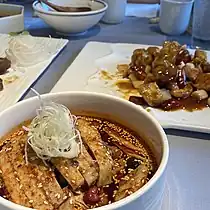 | 棒棒鷄 / 棒棒雞 | 棒棒鸡 | bàngbàng jī | Chicken mixed with dark, toasty sesame sauce. So-called from the sound of the cleavers being hammered into the chicken to shred it. [14] |
| Braised pork ribs with konjac | 魔芋燒排骨 | 魔芋烧排骨 | móyù shāo páigǔ | ||
| Chili oil wontons | .jpg.webp) | 紅油抄手 | 红油抄手 | hóng yóu chāoshǒu | |
| Dandan noodles | .jpg.webp) | 擔擔麵 | 担担面 | dàndàn miàn | Originally a Chengdu street snack sold by men with "carrying poles" (dan). [15] |
| Fish with pickled mustard greens | .jpg.webp) | 酸菜魚 | 酸菜鱼 | suān cài yú | Shredded chicken breast, pork, or any other meat ingredients can be substituted for the fish fillets. |
| Fragrant and spicy fish slices | 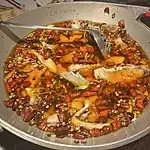 | 香辣魚片 | 香辣鱼片 | xiāng là yú piàn | |
| Hot and sour noodles |  | 酸辣麵, 酸辣粉 | 酸辣面, 酸辣粉 | suān là miàn, suān là fěn | Typically a vegetarian noodle dish primarily made with brassica juncea, vinegar, hot oil, and soy sauce. It has different flavors such as sour, sweet, fragrant, spicy and salty. Commonly is for breakfast but also a popular street snack in Sichuan, Yunnan, and Hubei. |
| Hot and sour noodle soup | .jpg.webp) | 酸辣肉絲湯麵 | 酸辣肉丝汤面 | suān là ròu sī tāngmiàn | Noodle soup dish primarily made with the ingredients of brassica juncea, stir-fried shredded meat, noodle, and broth. |
| Kung Pao beef tendon | 宮保牛筋 | 宫保牛筋 | gōngbǎo niú jīn | ||
| Kung Pao chicken | _-_%E5%AE%AE%E4%BF%9D%E9%9B%9E%E4%B8%81%EF%BC%88%E5%9C%A8%E5%8A%A0%E5%88%A9%E7%A6%8F%E5%B0%BC%E4%BA%9E%E5%B7%9E%E7%9A%84%E5%BC%97%E9%9B%B7%E6%96%AF%E8%AB%BE%EF%BC%89.jpg.webp) | 宮保雞丁 | 宫保鸡丁 | gōngbǎo jīdīng | Beef or lamb can be substituted for the chicken. |
| Mao xue wang |  | 毛血旺 | 毛血旺 | máo xuě wàng | Traditional dish from Chongqing made from pig's blood, tripe, duck's blood, ham and chicken gizzard. Beansprouts, chili, Sichuan peppercorn, sesame and other spices are often added as seasoning. |
| Mapo doufu | 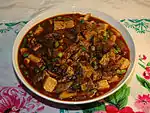 | 麻婆豆腐 | 麻婆豆腐 | mápó dòufǔ | Literally "pockmarked Ma's tofu". Spicy sauce similar to yuxiang ("in the style of fish") sauce.[16] |
| Sliced beef/beef tripe/ox tongue in chili sauce |  | 夫妻肺片 | 夫妻肺片 | fūqī fèipiàn | Literally "husband and wife lung pieces" |
| Shredded chicken cold noodles | 雞絲涼麵 | 鸡丝凉面 | jī sī liáng miàn | ||
| Shredded pork in garlic sauce |  | 魚香肉絲 | 鱼香肉丝 | yúxiāng ròusī | Literally "sliced pork with fish aroma" |
| Sichuan hotpot |  | 四川火鍋 | 四川火锅 | Sìchuān huǒguō | |
| Stir-fried green beans[17] | .jpg.webp) | 乾煸四季豆 | 干煸四季豆 | gān biān sìjì dòu | Also known as "Dry Fried Green Beans",[18] "Dry Fried String Beans",[19] "Sichuan Style Green Beans",[20] "Szechuan Dry Fried Green Beans",[21] or "Spicy Green Beans"[22] |
| Spicy deep-fried chicken | _(2269517013).jpg.webp) | 辣子雞 | 辣子鸡 | làzǐjī | |
| Tea-smoked duck | 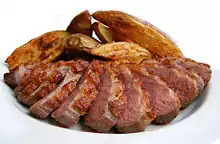 | 樟茶鴨 | 樟茶鸭 | zhāngchá yā | |
| Three-pepper chicken | 三椒煸雞 | 三椒煸鸡 | sān jiāo biān jī | ||
| Double-cooked pork |  | 回鍋肉 | 回锅肉 | huíguōròu | Literally "meat returning to the wok". Fresh pork is first boiled, then fried.[23] |
| Water-cooked meat |  | 水煮肉 | 水煮肉 | shuǐzhǔ ròu | |
| Steamed sweet pork with sticky rice. | 甜燒白 | 甜烧白 | tián shāo bái | Fill mashed red beans into sliced pork belly and lay the pork on steamed sweet sticky rice. | |
| Fish-fragrant eggplant |  |
魚香茄子 | 鱼香茄子 | yúxiāng qiézi | Steamed eggplant in a sauce commonly used in cooking fish [24] |
| Shredded chicken salad |  Sichuan shredded chicken salad |
涼拌雞絲 | 凉拌鸡丝 | liáng bàn jī sī | Shredded chicken mixed with spicy garlic sauce. |
| Bo-bo chicken | 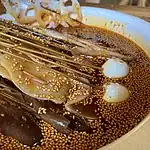 |
缽缽雞 | 钵钵鸡 | bǒbǒ jī | A kind of cold hot pot filled with vegetables and chicken on wooden sticks, different from Bon bon chicken. |
| Mala duck tongue |  |
麻辣鴨舌 | 麻辣鸭舌 | málà yā shé | Duck tongues stir-fried with Sichuan pepper and chili. |
| Stir-fried chicken kidney |  |
爆炒腰花 | 爆炒腰花 | bàochǎo yāo huā | Stir-fried chicken kidney with pickled pepper sauce. |
| Sichuan signature barbecue | 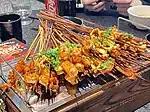 |
川味燒烤 | 川味烧烤 | chuān wèi shāo kǎo | Barbecue with Sichuan pepper as seasoning. |
| Leshan douhua | 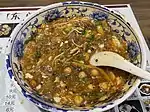 |
樂山豆腐腦 | 乐山豆腐脑 | lèshān dòu fǔ nǎo | Tender tofu with specially made sauce, originated from Leshan, Sichuan. |
| Leng chi tu | 冷吃兔 | 冷吃兔 | lěng chī tù | Marinated spicy rabbit meat. | |
See also
References
- ↑ Dunlop (2003), p. 23-24.
- ↑ UNESCO (2011). "Chengdu: UNESCO City of Gastronomy". UNESCO. Retrieved May 26, 2011.
- 1 2 3 4 Anderson, E.N. (2003). "Sichuan (Szechuan) Cuisine". Encyclopedia of Food and Culture. New York: Scribner's. pp. 393–395.
- ↑ Fu, Peimei (傅培梅) (2005). 培梅名菜精選:川浙菜专辑 [Peimei's Selection of Famous Dishes: Special Edition on Sichuan and Zhejiang Cuisine] (in Traditional Chinese). Tangerine Culture Enterprise Co., Ltd. (橘子文化事業有限公司). p. 9.
- ↑ Greer, Charles E. and Muranov, Aleksandr Pavlovich. "Yangtze River | Location, Map, Flood, & Facts | Britannica". www.britannica.com. Retrieved 2022-04-25.
{{cite web}}: CS1 maint: multiple names: authors list (link) - ↑ Tropp, Barbara (1982). The Modern Art of Chinese Cooking. New York: Hearst Books. p. 183. ISBN 0-688-14611-2.
- ↑ Geng, Olivia (June 13, 2014). "French Rabbit Heads: The Newest Delicacy in Chinese Cuisine". The Wall Street Journal Blog.
- ↑ Ji, Yue; Li, Shiming; Ho, Chi-Tang (2019-06-01). "Chemical composition, sensory properties and application of Sichuan pepper (Zanthoxylum genus)". Food Science and Human Wellness. 8 (2): 115–125. doi:10.1016/j.fshw.2019.03.008. ISSN 2213-4530. S2CID 132482961.
- ↑ "十大经典川菜 你吃过哪些?". 阿波罗新闻网 (in Chinese (China)). 2014-11-18. Retrieved 2020-11-05.
- ↑ "The Significant Visual Symbols Design, Logo Design Study of Chong Qing Hot Pot Brand"
- ↑ "成都街头的冷啖杯,本地人习以为常,可是外地人却看不懂_生活". Sohu.
- ↑ "成都消夏饮食冷啖杯"
- ↑ Dunlop (2003), p. 219-220.
- ↑ Dunlop (2003), p. 45.
- ↑ Dunlop (2003), p. 87-88.
- ↑ Ciang (1976), p. 220-221.
- ↑ Chan, Kei-lum; Fong-Chan, Diora (2016). China: The Cookbook. London: Phaidon. p. 500. ISBN 9780714872247.
- ↑ Hsiao-Ching Chou. "Dry Fried Green Beans". Chinese Soul Food. Chinese Soul Food. Retrieved 25 April 2019.
- ↑ Lee Hwa-lin (1993). Chinese Cuisine: Szechwan Style. Taipei, Taiwan: Chin Chin Publishing Co.Ltd. p. 78. ISBN 0941676315.
- ↑ "Green Beans, Sichuan Style". Flavor and Fortune. Institute for the Advancement of the Science and Art of Chinese Cuisine. Retrieved 25 April 2019.
- ↑ "Szechuan Dry Fried Green Beans (Simplified version)". China Sichuan Food. 11 October 2017. Retrieved 25 April 2019.
- ↑ Manyee Elaine Mar (November 18, 2013). The Everything Chinese Cookbook: Includes Tomato Egg Flower Soup, Stir-Fried Orange Beef, Spicy Chicken with Cashews, Kung Pao Tofu, Pepper-Salt Shrimp, and hundreds more! (2nd ed.). Avon, Massachusetts: F+W Publications, Inc. p. 255. ISBN 9781440568190.
- ↑ Chiang (1976), p. 94-95.
- ↑ Chiang (1976), p. 250-251.
Further reading
- Dunlop, Fuchsia (2003), Land of Plenty: A Treasury of Authentic Sichuan Cooking, New York: Norton, ISBN 0393051773. Internet Archive ONLINE
- Fuchsia Dunlop. Shark's Fin and Sichuan Pepper: A Sweet-Sour Memoir of Eating in China. (New York: Norton, 2008). ISBN 9780393066579. The author's experience and observations, especially in Sichuan.
- Chiang, Jung-Feng (1976), Mrs. Chiang's Szechwan Cookbook : Szechwan Home Cooking, Ellen Schrecker and John E. Schrecker, New York: Harper & Row, ISBN 006015828X. Internet Archive ONLINE.
- E. N. Anderson. "Sichuan (Szechuan) Cuisine," in Solomon H. Katz, William Woys Weaver. Encyclopedia of Food and Culture. (New York: Scribner, 2003; ISBN 0684805685). Vol I pp. 393–395.
- Lu Yi, Du li. China Sichuan Cuisine (Chinese and English) Bilingual . Sichuan Publishing House of Science and Technology, 2010. ISBN 9787536469648.
- Che Fu. Talk About Sichuan Flavor (Chinese Edition). Sichuan Literature & Art Publishing, 2011. ISBN 978-7541131523.